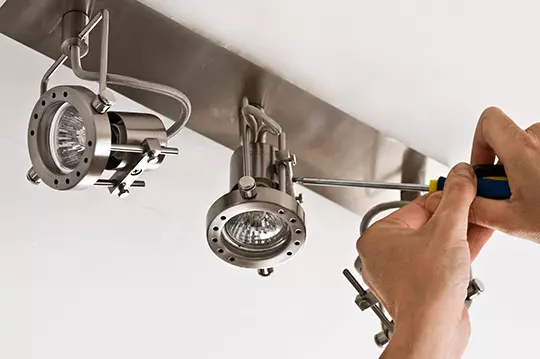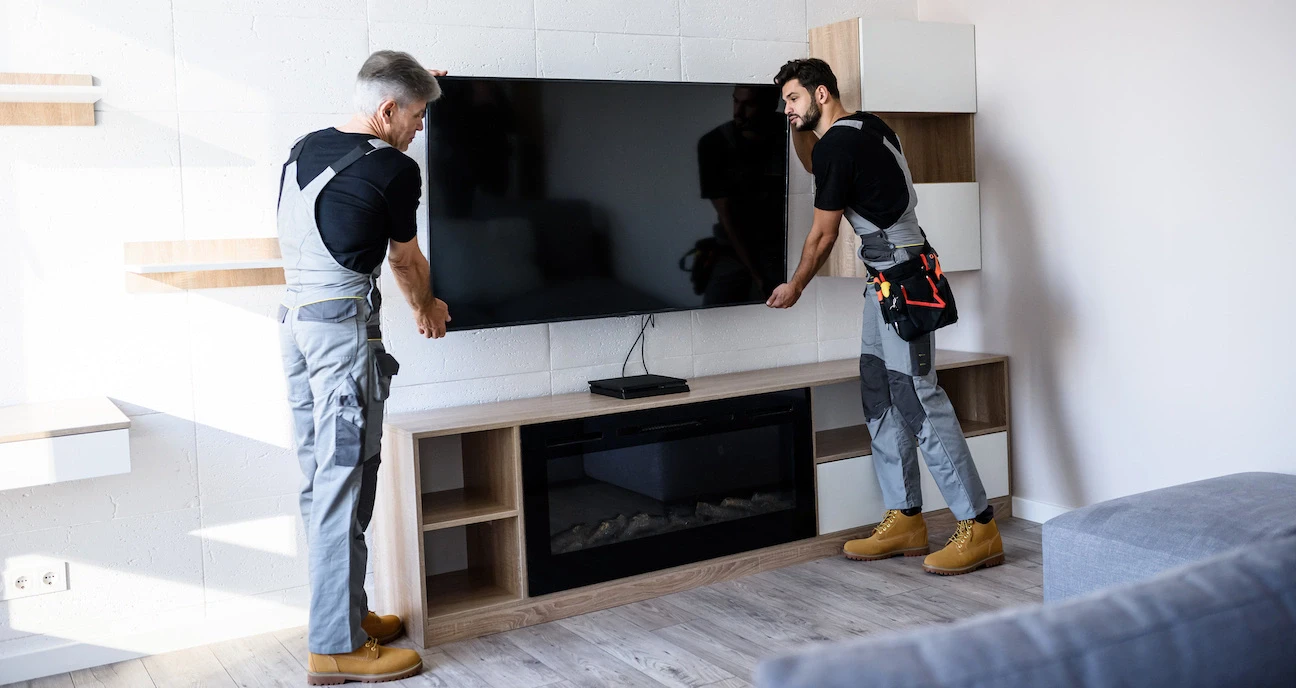Home electrical systems are an essential part of our daily lives. They provide power to our appliances, lighting, and other electrical devices. But, electrical problems can be dangerous and disruptive if not addressed promptly.
In this ultimate guide, we will provide you with all you need to know. From identifying electrical problems to DIY Repair tips. Additionally, You will discover a checklist to prevent electrical issues plus how to find a reliable electrical handyman.
Before attempting any electrical repairs, identifying the source of the problem is crucial.
Here are some common electrical problems and how to troubleshoot them:
Call Kaminskiy Care & Repair today so our skilled electricians can help you with your project!
Homeowners can fix some electrical problems, but it is essential to prioritize safety. Know your limits. Here are some essential tips for fixing electrical issues at home:

1. Prioritize safety
Always turn off the power to the circuit you are working on. Do this by switching off the corresponding circuit breaker. Use insulated tools and protective gear. This helps minimize the risk of electrical shock.
2. Proper Wiring
When making electrical connections, ensure that wires are properly stripped, twisted together, and secured with wire nuts or electrical tape. Avoid using excessive force when tightening connections.
3. Upgrading Outlets
Consider upgrading older two-prong outlets to three-prong grounded outlets for improved safety. However, consult a professional electrician if you are unsure about the wiring requirements.
4. Ground Fault Circuit Interrupters (GFCIs)
Install Ground Fault Circuit Interrupters (GFCIs) in areas prone to moisture. These areas include bathrooms, kitchens, and outdoor spaces. These outlets provide additional protection against electrical shocks.
5. Regular maintenance
Periodically inspect your electrical system for signs of wear. Look for frayed wires or loose connections. Replace damaged components promptly to prevent potential hazards.
Prevention is key when it comes to electrical problems. Follow this checklist to maintain a safe and functional electrical system at home:
1. Schedule regular inspections.
Hire a licensed electrician to conduct annual inspections of your electrical system. This will help identify any potential issues.
2. Avoid Overloading Circuits
Do not plug too many devices into a single outlet or circuit. Distribute the electrical load evenly to prevent circuit overloads.
3. Use Surge Protectors.
Install them to safeguard sensitive electronic devices from power surges and voltage spikes.

4. Keep Electrical Cords in Good Condition
Check cords for fraying or damage and replace them if necessary. Avoid running cords under carpets or rugs, as this can cause overheating.
5. Outdoor Electrical Safety
Ensure that outdoor outlets and electrical equipment are weatherproof. Ensure they are also protected from moisture. Use outdoor-rated extension cords for outdoor use.
6. Install outlet covers or tamper-resistant outlets
This will prevent children from inserting objects into outlets and also prevent shock incidents
Efficient wiring is essential for ensuring the safety, functionality, and longevity of electrical systems in our homes and workplaces. Proper wiring practices prevent electrical hazards.
They also optimize energy usage and reduce the risk of electrical failures. We will examine some of the best practices for efficient wiring every homeowner and electrician should follow.

Plan and Design
Before starting any wiring project, it is crucial to plan and design the layout carefully. Consider the electrical needs of each room. Consider the location of outlets and switches, as well as the load requirements. A well-thought-out plan will minimize the need for additional wiring. It will also ensure efficient power distribution.
Use Quality Materials
Investing in high-quality wiring materials is essential for long-term efficiency. Use copper wiring instead of aluminum. Copper has better conductivity and is less prone to corrosion. Additionally, choose wiring insulation suitable for the specific application and environment. This prevents damage and electrical leakage.
Proper Wire Sizing
Using the correct wire size is crucial for efficient electrical distribution. Undersized wires can lead to overheating and potential fire hazards. Oversized wires are wasteful and inefficient. Consult the National Electrical Code (NEC) or consult with a professional electrician. Determine the appropriate wire size for each circuit.
Organize and Label
Proper organization and labeling of wiring systems make troubleshooting and maintenance much easier. Use color-coded wires. Label each circuit breaker. Do this to quickly identify and isolate any issues. This practice saves time and reduces the risk of errors during repairs or upgrades.
Regular Maintenance
Regular maintenance is essential for efficient wiring. Inspect wiring systems periodically for signs of wear, damage, or loose connections. Replace any faulty components promptly to prevent electrical failures and potential hazards.
Following these best practices for efficient wiring ensures the safety, functionality, and longevity of electrical systems.
Installing electrical outlets and switches may seem straightforward. However, it is crucial to proceed with caution to ensure safety and functionality. Unfortunately, many homeowners make common mistakes during installation. These can lead to electrical hazards or functionality issues. We will discuss some of these mistakes and how to avoid them.
Failure to Turn the Power Off
One common mistake is not turning off the power before starting the installation. Failing to switch off the power can result in electrical shocks or even fires. Always turn off the circuit breaker or fuse that controls the area where you are planning to install the outlet or switch.
Improper Wiring
Another mistake is using improper or incompatible wiring. It is important to use the correct gauge and type of wire for the specific electrical load. Using undersized or inappropriate wiring can lead to overheating and electrical failures. If you are unsure about the correct wire to use, consult a professional electrician.
Failure to Ground Outlets and Switch
Additionally, not properly grounding the outlets and switches is a common error. Grounding protects against electrical shocks and helps to stabilize electrical currents. Ensure that you connect the ground wire securely to the grounding screw or terminal.
Not Using a Junction Box.
Another mistake to avoid is not installing a junction box for outlets and switches. Junction boxes provide a secure housing for electrical connections. They also protect against accidental contact with live wires. Never leave exposed wires or connections.
Non-compliance with Electrical codes and Regulations
Last but not least, not following local electrical codes and regulations is a grave error. These codes are in place to ensure the safety of the electrical system. To avoid penalties and potential hazards, familiarize yourself with the electrical installation requirements in your area.
Avoid these common mistakes when installing electrical outlets and switches. Doing so will ensure the safety, functionality, and longevity of your electrical system. If you are unsure about any aspect of the installation process, consult with a qualified electrician. Remember, safety should always be the top priority when working with electricity.
In some cases, electrical problems may require the expertise of a professional electrician. Here are some tips for finding an electrician for emergency needs:
Research and Recommendations
Ask friends, family, or neighbors for recommendations on reliable electricians in your area. Conduct online research and read reviews to narrow down your options.
Licensing and Insurance
Ensure that the electrician you hire is licensed, insured, and bonded. This protects you from liability in case of accidents or damages. It happens during the repair process.
Emergency Services
Look for electricians who offer 24/7 emergency services. This will help to address urgent electrical issues promptly.
Experience and Expertise
Choose an electrician with experience in handling your specific electrical problem. Specialized knowledge can ensure a more efficient and effective resolution.
Obtain Different Quotes.
Request quotes from multiple electricians. Compare prices and services offered. However, prioritize quality and reliability over cost alone.
Installing and maintaining home electrical systems requires knowledge, caution, and sometimes professional help.
Follow the troubleshooting tips, essential repair guidelines, and preventive measures in this guide. Doing so can help you address common electrical problems.
Remember, safety should always be your top priority. When in doubt, consult a professional electrician. We at Kaminskiy Care and Repair provide tailored electrical solutions to your needs. This gives you peace of mind.
With modern appliances, intricate wiring solutions are often necessary. Our team of expert electrical handyman has the expertise to manage the installation of wiring for a diverse array of appliances, guaranteeing secure connections and optimal function.
The soundness of your home’s electrical system rests on its wiring and switches. Our experts possess the skills to investigate and mend any problems, such as lights that dim or defective switches, guaranteeing dependability and safety for your electrical setup.
Our top priorities are safety, quality, and customer satisfaction. Count on us to handle your electrical needs with the utmost expertise and attention to detail.
For issues like tripping breakers, we first diagnose the root cause, which could be due to overloaded circuits or outdated wiring. Our skilled technicians can then perform necessary upgrades or repairs, ensuring your system meets current safety standards and efficiency.
While simple tasks like replacing a light bulb are manageable, we recommend professional handling for most electrical repairs. Electrical work can be hazardous, and our licensed handyman electricians ensure repairs are done safely and up to code.
A Ground-Fault Circuit Interrupter (GFCI) is crucial for preventing electric shocks, particularly in areas exposed to moisture like bathrooms and kitchens. We can install or replace GFCIs to enhance safety in your home.
For homes with aluminum or knob and tube wiring, we provide comprehensive inspection and retrofitting services. We ensure that all connections are safe and recommend upgrades if necessary to meet modern safety standards.
Whole Home Surge Protection safeguards your appliances and electronics from power surges. We offer installation services for these systems, providing an additional layer of protection for your home.
Regular maintenance is key to preventing electrical hazards. We offer inspection and maintenance services, where we check for signs of wear, faulty wiring, and potential hazards in your electrical system and appliances.
Safety is our top priority. We adhere to strict safety protocols and codes. Our team of professional handymen is equipped with the right tools and training to handle electrical repairs and installations safely and efficiently.